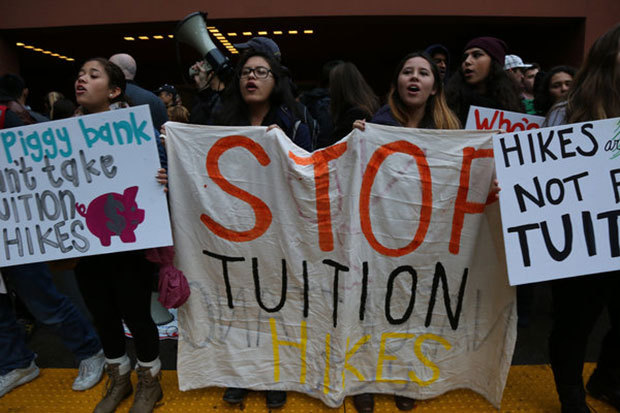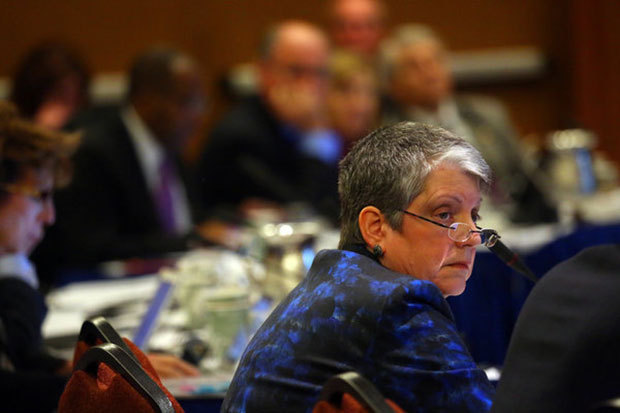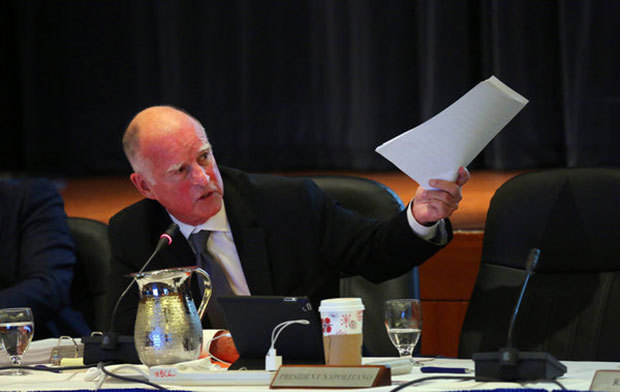University of California Is Set to Raise Tuition

By RICHARD PÉREZ-PEÑA
SAN FRANCISCO — Over the protests of hundreds of angry and chanting students, a panel of the University of California Board of Regents gave preliminary approval Wednesday to a plan to raise tuition 27.6 percent over five years, turning aside a last-ditch effort by Gov. Jerry Brown to block it.
The day unfolded as a showdown between Mr. Brown, who holds himself out as a force for fiscal restraint, and Janet Napolitano, the president of the university system, who has insisted that only more money from the state can head off the tuition increase. Mr. Brown has countered that if the regents went ahead with the increase, they would get less from Sacramento, not more, and he bolstered his position by appointing two allies this week to vacant seats on the board.
But even as sign-waving protesters tried to block entrances to the building, which led to shoving and jostling as officials tried to make their way in, Ms. Napolitano got her way: Under the plan, undergraduate tuition and fees for California residents would rise from $12,192 a year to as much as $15,560 in 2019-20.

Out-of-state students, who now pay more than $35,000 in tuition and fees, could see those charges rise to nearly $45,000. And those figures do not cover room and board, now about $14,000 for all students.
California’s prices are far above the national average of about $9,100 in tuition and fees for public four-year colleges, but below some, including elite public institutions like the University of Michigan and the University of Virginia. And California officials say that with financial aid to low- and middle-income students, more than half of California residents pay no tuition, and that would remain true after the increases.
People on both sides argued that at stake was nothing less than the basic character of one of the nation’s largest university systems: whether it can remain elite, yet still accessible to middle- and working-class families.
“I would have real trouble paying any more, and so would a lot of people,” said Buckminster Barrett, an undergraduate at the Santa Cruz campus. “They say they’re worried about student debt, but this would force a lot of us to take more loans.”
But after almost four hours of debate, and with students in the audience drowning out the regents’ voices with their chants, a committee of the board voted 7 to 2 to approve increases of up to 5 percent in each of the next five years. A vote of the full board is expected Thursday, and regents taking head counts based on the debate said it appeared likely that the plan would pass.
The clash between Mr. Brown and Ms. Napolitano pitted two powerful Democrats and experienced political infighters against each other. On Wednesday, the governor, who sits on the board, asked the regents to delay voting on the plan until their next meeting in January, and to form a committee to find ways for the university to overhaul the way it does business.
“The pressure of not having enough money can force creativity that otherwise cannot even be considered,” Mr. Brown said. And, in the meantime, “we’re not talking that there’s a scarcity here that makes it impossible to live with,” he added.

Ms. Napolitano, a former secretary of Homeland Security and governor of Arizona, insisted that 5 percent was a ceiling, and that the figure could still be reduced if state lawmakers pitched in more money. Citing “massive state disinvestment” during the recent recession, budget cuts that eliminated thousands of university jobs, and a three-year tuition freeze, she said the system had no choice but to raise tuition to sustain quality and enable students, families and administrators to plan for the future.
“I wanted tuition increases to be as low as possible and as predictable as possible,” she said.
Starting during the recession, California cut support for the university system by $1 billion a year, prompting tuition increases of more than 60 percent, after inflation.
Systemwide, state support has rebounded partly in the last two years, and now supplies $2.8 billion of the university system’s nearly $7 billion core operating budget. But as regents and university trustees noted repeatedly, it remains well below its peak, despite increased costs and enrollment that has grown to more than 230,000 students.
Versions of California’s higher education battles have been playing out in states across the country in recent years. State governments slashed support for public universities during the recession, driving big tuition increases and drawing criticism from political leaders. In several states, university administrators have frozen tuition, while protesting that they are still underfunded by their states.
Recent efforts by some University of Texas regents to oust William Powers Jr., the president of the flagship Austin campus, were prompted in part by his repeated calls for higher tuition, as the regents imposed a multiyear freeze.
The California students who descended on the university conference center here where the regents met — driving or taking buses from campuses across the state — had harsh words for both state lawmakers and the regents. But they aimed most of their ire at Ms. Napolitano and called for her resignation. Many said they had been turned into pawns in a larger political game.

“They’re all at fault — all of them,” said Victor Ye, a student at the Berkeley campus.
Mike Hirshman, president of the Graduate Students Association at the Los Angeles campus, said of the regents, “You may be frustrated with the state, but it doesn’t absolve you of responsibility to keep our education affordable.”
In his address to the regents, Mr. Brown called on the university to look into changes like three-year bachelor’s degrees, concentrating some specialties at specific campuses, raising the number of students admitted as transfers from community colleges, sharply increasing online courses, and giving college credit for work experience. Those ideas are being debated across the country as cost-savers and ways to get more people through college, but many educators see them as an erosion of standards.
Mr. Brown has proposed 4 percent annual increases in state support for the system, but Ms. Napolitano and her allies contend that is not nearly enough. They said that if the state gave more, they would shrink the tuition increase. The governor said he would withhold the 4 percent increase if the regents went ahead with raising tuition.
In keeping with the bare-knuckled prelude, the meeting was characterized by sharp exchanges. John A. Pérez, a former Assembly speaker and one of the newly appointed regents who spoke against the tuition plan, said, “If you come in in a hostage-taking posture, saying give us X or this is what we’re going to do to our students, it’s not the most productive path.”
Responding to Mr. Brown’s proposal, Ms. Napolitano said, “We don’t have time to wait for another commission.” But, she conceded, “maybe we’ll actually get some nifty ideas out of it — that’s always possible,” prompting scattered laughter.
Another regent, Richard C. Blum, who is married to Senator Dianne Feinstein, a Democrat, endorsed the tuition increase, arguing that the system simply needed more money to stay competitive. Referring to the years of cutting, he said it was harder than ever to debate the matter civilly, describing himself as “apoplectic.”
Mr. Brown replied, “Money doesn’t buy everything in the world.” Noting pointedly that Mr. Blum is an investment banker, the governor added: “This is not Wall Street. This is the University of California.”
[Source]: New York Times


